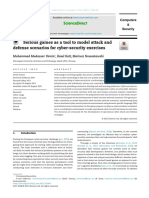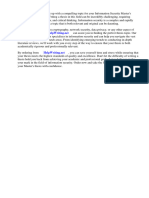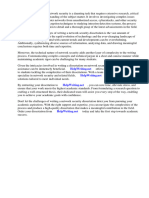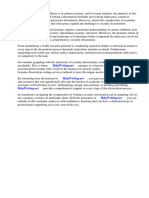Information Assurance Security (IAS)
Information Assurance Security (IAS)
Uploaded by
amenabera469Copyright:
Available Formats
Information Assurance Security (IAS)
Information Assurance Security (IAS)
Uploaded by
amenabera469Copyright
Available Formats
Share this document
Did you find this document useful?
Is this content inappropriate?
Copyright:
Available Formats
Information Assurance Security (IAS)
Information Assurance Security (IAS)
Uploaded by
amenabera469Copyright:
Available Formats
DIRE DAWA UNIVERSITY
INSTITUTE OF TECHNOLOGY
Department of Information Technology
Group Assignment
The main purpose is to prepare students for understanding the case study aspects of Information
Assurance Security
case study: Securing Project Cobalt: A CISO’s Journey
Acme Inc., a global leader in sustainable energy solutions, was on the verge of a
breakthrough. Project Cobalt, their top-secret initiative for a revolutionary battery
technology, held the potential to reshape the energy landscape. But with such sensitive
information, the stakes were high. A data breach could cripple Acme and empower their
competitors.
Enter Sarah, the newly appointed Chief Information Security Officer (CISO). Aware of the
immense value of Project Cobalt, Sarah knew a strong cybersecurity strategy was principal.
She envisioned a multifaceted approach built on the core principles of cryptography.
Sarah implemented Advanced Encryption Standard (AES), an industry-standard symmetric
algorithm, to scramble Project Cobalt data. Only authorized users with the decryption key
could access the information. Users needed not just their usernames and passwords, but also
a unique code from a security token to access Project Cobalt. This added layer made
unauthorized access significantly harder. Secure audit logs, encrypted with tamper-proof
techniques, documented every access attempt and action on Project Cobalt data. This
provided a certain record, preventing anyone from denying their involvement.
Sarah understood the criticality of the encryption keys. She implemented a Hardware
Security Module (HSM), a tamper-resistant device specifically designed to store and manage
cryptographic keys. This drastically reduced the risk of key theft or compromise. Sarah
recognized that technology alone wasn't enough. Comprehensive security awareness training
educated employees on potential threats and best practices.
A culture of cybersecurity was fostered, making everyone accountable for protecting Project
Cobalt. Acme's multifaceted approach, built on the core principles of cryptography, proved
successful. Project Cobalt remained secure, allowing the team to focus on innovation. The
robust security strategy not only protected sensitive information but also instilled confidence
in investors and partners.
The questions below are grounded in the above case study, aiming to delve into the security strategy
implemented at Acme Inc. for safeguarding Project Cobalt, a revolutionary battery technology. Through
a detailed analysis using the Information Assurance Security (IAS) framework, please comprehensive
discus.
1. As a newly appointed CISO, Sarah faced immense pressure to secure Project Cobalt.
How did her leadership style and approach to risk management influence the chosen
security strategy?
2. What personal qualities do you think Sarah possessed that helped her overcome these
challenges?
3. The success of the security strategy relied heavily on user cooperation. How effective do
you think the implemented security awareness training was in fostering a culture of
cybersecurity at Acme?
4. Imagine yourself as an employee at Acme during the implementation of the new security
measures. How do you think these changes might have affected your daily work routine?
Would the benefits compensate for the potential inconveniences? (Provide a subjective
perspective on the impact of security measures)
5. The case study focuses on established cryptographic solutions like AES and HSMs. Do
you think Sarah's strategy was overly conditional on convergence approaches? Could
there have been room for exploring more cutting-edge security solutions?
6. The case study doesn't explore the specific details of the implemented security measures.
Based on the information provided, what potential drawbacks or vulnerabilities do you
see in Sarah's security architecture?
7. The case study paints a picture of success. Do you think the positive outcome is solely
attributable to the implemented security strategy, or were there other contributing factors?
(Expands the argument beyond just cryptography)
8. Imagine Acme is considering replicating this security strategy for a future top-secret
project. What are some key learnings from Project Cobalt's success that could be applied
to future endeavors?
9. In a scenario where Project Cobalt, currently reliant on IPv4, decides to undertake the
intimidating task of transitioning to IPv6, all while managing the distinctions of Windows
Vista security, a real-world case clarifies. This intense journey intensely describes the
challenges faced by the Acme during the transition, exploring the specific security
implications that arose in the context of Windows Vista and the coexistence of IPv4 and
IPv6?
10. Could you provide a concise yet compelling summary of your course material covered in
chapters 1 and 2 with this case study?
Note!
In this case study, you are required to write (Only handwritten answer) a proper and
compiled report on what you are answered, and copied documents will be completely
rejected.
A maximum number of students per group is 10. All group members should contribute to
and agree on your work before submission and presentation.
finally, each member of group must be present your work
submission and presentation Date: -04/01/2024
You might also like
- Network Security Research Papers IeeeDocument6 pagesNetwork Security Research Papers Ieeejppawmrhf100% (1)
- Research Paper On Network Security SystemDocument8 pagesResearch Paper On Network Security Systemh015trrr100% (1)
- Certificate of Cloud Security Knowledge GuideDocument12 pagesCertificate of Cloud Security Knowledge GuideJhon RojasNo ratings yet
- Research Papers On Network Security Its IssuesDocument7 pagesResearch Papers On Network Security Its Issueskmffzlvkg100% (1)
- Research Paper Wireless SecurityDocument7 pagesResearch Paper Wireless Securityefjk5y50100% (1)
- Research Paper Topics in Computer SecurityDocument4 pagesResearch Paper Topics in Computer Securitynlaxlvulg100% (1)
- Research Paper On Network SecurityDocument4 pagesResearch Paper On Network Securityafnkwiytzcpszv100% (1)
- Research Paper On Embedded System SecurityDocument4 pagesResearch Paper On Embedded System Securityefhwx1vt100% (1)
- Computer Security Research Paper ExampleDocument6 pagesComputer Security Research Paper Exampleegx124k2100% (1)
- Master Thesis Cloud SecurityDocument6 pagesMaster Thesis Cloud SecurityWriteMyPaperForMeSpringfield100% (2)
- Cloud Security Thesis TopicsDocument7 pagesCloud Security Thesis Topicsbsgyhhnc100% (2)
- Literature Review of Security in Cloud ComputingDocument4 pagesLiterature Review of Security in Cloud Computingafmziepjegcfee100% (1)
- Network SecurityDocument5 pagesNetwork Securitykarthiga RNo ratings yet
- Ieee Research Papers On Network Security 2013Document6 pagesIeee Research Papers On Network Security 2013jpccwecnd100% (1)
- Research Paper On Security in Cloud ComputingDocument4 pagesResearch Paper On Security in Cloud Computingzhzafmhkf100% (1)
- Web Application Security Research PaperDocument4 pagesWeb Application Security Research Papercjyjcyakf100% (1)
- Cado Security Labs 2023 Cloud Threat Findings ReportDocument19 pagesCado Security Labs 2023 Cloud Threat Findings Reporttravis.greenNo ratings yet
- 1 s2.0 S0167739X22002254 MainDocument21 pages1 s2.0 S0167739X22002254 MainMuhammad TanveerNo ratings yet
- Ieee Research Papers On Network Security PDFDocument8 pagesIeee Research Papers On Network Security PDFefdvje8d100% (1)
- Wireless Network Security DissertationDocument4 pagesWireless Network Security DissertationSomeToWriteMyPaperCanada100% (1)
- Email Security Research PaperDocument4 pagesEmail Security Research Paperwopugemep0h3100% (1)
- Ieee Research Paper On Cloud Computing SecurityDocument5 pagesIeee Research Paper On Cloud Computing Securitygw1m2qtf100% (1)
- CloudprintDocument9 pagesCloudprintSourabh porwalNo ratings yet
- Dissertation Ideas Computer SecurityDocument5 pagesDissertation Ideas Computer SecurityCollegePaperWritingServiceReviewsColumbia100% (1)
- Research Paper On Network Security 2015Document4 pagesResearch Paper On Network Security 2015krqovxbnd100% (1)
- Thesis v5.1Document35 pagesThesis v5.1Root LindowNo ratings yet
- Cloud Computing Security Thesis PDFDocument6 pagesCloud Computing Security Thesis PDFdnr68wp2100% (2)
- Research Paper On Private SecurityDocument4 pagesResearch Paper On Private Securitywonopwwgf100% (1)
- Online Cyber Security CourseDocument17 pagesOnline Cyber Security Courseharikrishna rajaneniNo ratings yet
- Information Security Literature ReviewDocument7 pagesInformation Security Literature Reviewfahynavakel2100% (1)
- Cyber Security Research Paper 2015Document5 pagesCyber Security Research Paper 2015egyr68dw100% (1)
- Web Application Security DissertationDocument6 pagesWeb Application Security DissertationHelpWritingPapersForCollegeCanada100% (1)
- Cyber Security Research Paper PDFDocument5 pagesCyber Security Research Paper PDFfvhgssfm100% (1)
- Cloud Full MaalDocument9 pagesCloud Full MaalSourabh porwalNo ratings yet
- Research Paper On Web Application SecurityDocument4 pagesResearch Paper On Web Application Securitygw0q12dxNo ratings yet
- Research Paper On Information Security Management SystemsDocument4 pagesResearch Paper On Information Security Management Systemsfysfs7g3No ratings yet
- Ieee Research Paper On Security in Cloud ComputingDocument7 pagesIeee Research Paper On Security in Cloud Computingafeeotove100% (1)
- Research Papers Computer Network SecurityDocument7 pagesResearch Papers Computer Network Securitytigvxstlg100% (1)
- Serious Games As A Tool To Model Attack and Defense Scenarios For Cyber-Security ExercisesDocument22 pagesSerious Games As A Tool To Model Attack and Defense Scenarios For Cyber-Security Exerciseschairul rachmanNo ratings yet
- Web Application Security Master ThesisDocument6 pagesWeb Application Security Master Thesistrinasimmonssavannah100% (2)
- Security Challenges and Issues in Cloud Computing - The Way AheadDocument4 pagesSecurity Challenges and Issues in Cloud Computing - The Way Aheadetylr mailNo ratings yet
- Master Thesis Computer SecurityDocument6 pagesMaster Thesis Computer SecurityLori Head100% (2)
- Wireless Security Research Paper PDFDocument6 pagesWireless Security Research Paper PDFcarkdfp5100% (1)
- Information Security Masters Thesis TopicsDocument8 pagesInformation Security Masters Thesis Topicsginaalfarostamford100% (2)
- M.tech Thesis Topics in Network SecurityDocument8 pagesM.tech Thesis Topics in Network Securityjedod0nelit3100% (2)
- Research Paper On Network Security TopicDocument5 pagesResearch Paper On Network Security Topichbzqwpulg100% (1)
- Research Papers On Big Data SecurityDocument9 pagesResearch Papers On Big Data Securityafnkazmquziwrf100% (1)
- Dissertation Topics in Computer Network SecurityDocument5 pagesDissertation Topics in Computer Network SecurityWriteMyBusinessPaperMidland100% (1)
- Research Paper On Networking SecurityDocument4 pagesResearch Paper On Networking Securitylzpyreqhf100% (1)
- Network Security DissertationDocument5 pagesNetwork Security DissertationWhereCanIFindSomeoneToWriteMyPaperNewark100% (1)
- Literature Review On Security Issues in Cloud ComputingDocument8 pagesLiterature Review On Security Issues in Cloud Computingc5pnmx9fNo ratings yet
- AI-Enhanced Cybersecurity: Machine Learning For Anomaly Detection in Cloud ComputingDocument14 pagesAI-Enhanced Cybersecurity: Machine Learning For Anomaly Detection in Cloud Computingالعلمي حسامNo ratings yet
- Research Paper On Information Technology SecurityDocument7 pagesResearch Paper On Information Technology SecurityxfykuuundNo ratings yet
- Network Security Dissertation TopicsDocument5 pagesNetwork Security Dissertation TopicsCustomPapersReviewUK100% (1)
- Security DissertationDocument7 pagesSecurity DissertationWriteMyEconomicsPaperSpringfield100% (1)
- Web Security DissertationDocument6 pagesWeb Security DissertationWriteMyCustomPaperSingapore100% (1)
- Research Paper On Cloud Computing Security IssuesDocument6 pagesResearch Paper On Cloud Computing Security Issuesgz45tyyeNo ratings yet
- Data Security in Cloud ComputingDocument6 pagesData Security in Cloud ComputingGo CareerNo ratings yet
- Master Thesis Information SecurityDocument6 pagesMaster Thesis Information SecurityWendy Belieu100% (2)



























































